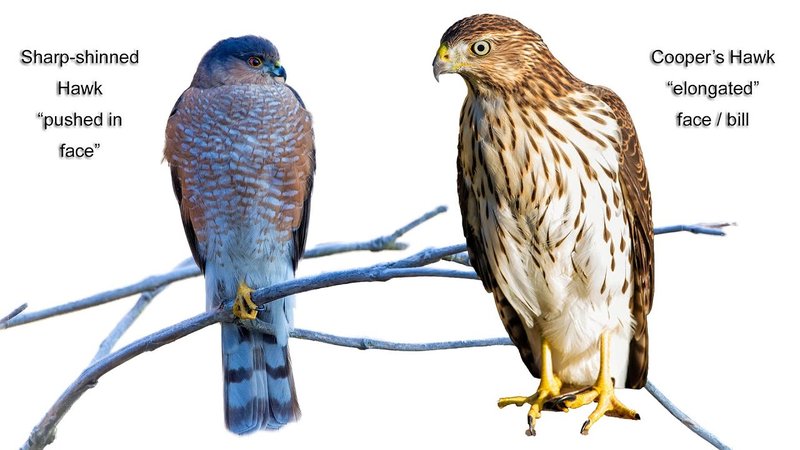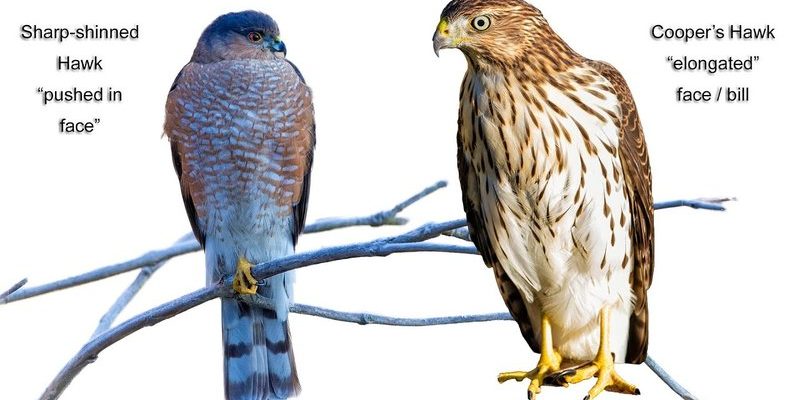
Imagine you’re in a café, chatting with a friend about birds. You might say, “Hey, have you ever seen a hawk? I saw one the other day, but I’m not sure if it was a Cooper’s Hawk or something else.” That curiosity is common among bird enthusiasts and beginners alike. In this guide, we’ll break down the key differences between the Cooper’s Hawk and similar species like the Sharp-shinned Hawk and the Red-shouldered Hawk. Grab your binoculars, and let’s dive in!
Identifying the Cooper’s Hawk
First things first, let’s talk about what makes the Cooper’s Hawk unique. This bird is medium-sized, typically measuring about 14 to 20 inches long. One of its standout features is its long tail, which it uses for agile flight through dense foliage. Cooper’s Hawks also sport a distinctive blue-gray plumage on their back and a white chest with reddish-brown bars.
Now, if you’re trying to identify this bird, think of its hunting style. Cooper’s Hawks are known for their remarkable speed and agility, especially in chasing after smaller birds. They often surprise their prey by darting through trees and bushes. If you spot a hawk acting stealthily, darting from branch to branch, there’s a good chance it’s a Cooper’s!
Size Matters
When comparing the Cooper’s Hawk to similar species, size is a crucial factor. The Sharp-shinned Hawk, for example, is slightly smaller, measuring about 9 to 13 inches. This difference can help you quickly narrow down your identification when you observe them in the wild. Here’s a quick comparison table to illustrate the size differences:
| Hawk Species | Length (inches) | Wingspan (inches) |
|---|---|---|
| Cooper’s Hawk | 14-20 | 28-36 |
| Sharp-shinned Hawk | 9-13 | 20-26 |
| Red-shouldered Hawk | 16-24 | 37-43 |
Spotting the Sharp-shinned Hawk
If you’re out birdwatching and see a smaller hawk flitting about, it’s likely a Sharp-shinned Hawk. This little guy is known for its sharp, pointed wings and a more compact body. Its coloration is similar to the Cooper’s, but it tends to have a more slender appearance.
These hawks often prefer open skies or forest edges, where they can quickly dart after sparrows and other small birds. Watching a Sharp-shinned Hawk hunt can be a heart-pounding experience. They’re speedy and make sudden turns, so keep your eyes peeled!
Behavior and Habitat
Behavior is another distinguishing factor. Sharp-shinned Hawks are more likely to hunt in trees, using their nimble size to navigate through branches. In contrast, Cooper’s Hawks tend to prefer more open areas and are often seen soaring above fields or gliding along tree lines.
If you’re trying to decide between the two, think about where you spot them. If it’s in dense woods, it’s probably a Sharp-shinned Hawk; if in open fields, you might just be lucky enough to see a Cooper’s Hawk.
Comparing to the Red-shouldered Hawk
Moving on to the Red-shouldered Hawk, this species is larger and has a more striking appearance thanks to its reddish shoulders and a creamy, banded chest. If you see a hawk perched prominently on a tree branch, showing off those vibrant colors, there’s a good chance it’s a Red-shouldered Hawk.
These hawks are known for their loud, distinctive calls. If you hear a call that sounds like a “Kree-kree-kree,” that’s likely a Red-shouldered Hawk announcing its presence. Their behavior contrasts with that of the Cooper’s Hawk, as they often prefer open woodlands or wet areas where they can hunt for small mammals and amphibians.
Physical Differences
In terms of physical differences, the Red-shouldered Hawk has a broader wing shape and a more robust body compared to the Cooper’s Hawk. Its tail is also shorter, and the banding is much more pronounced. You might feel like you’re comparing apples to oranges, but these subtle differences in color and size can help turn a casual birdwatching trip into an exciting identification adventure!
Habitat Preferences
Understanding habitat preferences is key to identifying these hawks. The Cooper’s Hawk loves woodlands but is also found near urban areas, making it somewhat of a chameleon in various environments. It’s not uncommon to see them in parks or gardens, especially during migration periods.
Meanwhile, the Sharp-shinned Hawk sticks to forested areas, often hanging around places with dense underbrush. They like to stay hidden while they wait for the perfect moment to strike their unsuspecting prey. Red-shouldered Hawks, on the other hand, thrive in moist woodlands and near rivers, lending to their diet that includes a variety of small mammals and reptiles.
If you’re exploring different habitats, remember that the presence of these hawks can often indicate the overall health of that ecosystem. Healthy habitats support diverse wildlife, including the birds you’re trying to spot.
Feeding Habits and Diet
Now let’s talk about what these hawks eat. Cooper’s Hawks primarily hunt small birds, which might make you think of them as the avian equivalent of a stealthy ninja. They rely on their speed and quick reflexes to catch their prey mid-flight.
Sharp-shinned Hawks have a similar diet, as both species enjoy dining on sparrows and finches. However, what sets them apart is the hunting strategy. The Sharp-shinned Hawk often uses a technique called “surprise attack,” where it waits for the right moment to suddenly dart out and catch its meal. It’s all about stealth and speed!
In contrast, the Red-shouldered Hawk prefers a more varied diet, including small mammals and even amphibians. This flexibility allows it to thrive in different environments. If you watch them hunting, you might see their patience as they perch silently before pouncing on unsuspecting prey.
Understanding the differences between the Cooper’s Hawk and similar bird species like the Sharp-shinned and Red-shouldered Hawk can enhance your enjoyment of birdwatching. Each has unique characteristics, behaviors, and habitats that make them special in their own right.
By getting familiar with their sizes, markings, and hunting habits, you can spot these incredible birds with confidence. Grab your binoculars, head outdoors, and enjoy the thrill of identifying these stunning hawks in their natural habitat. Who knows what you’ll discover? Happy birdwatching!

